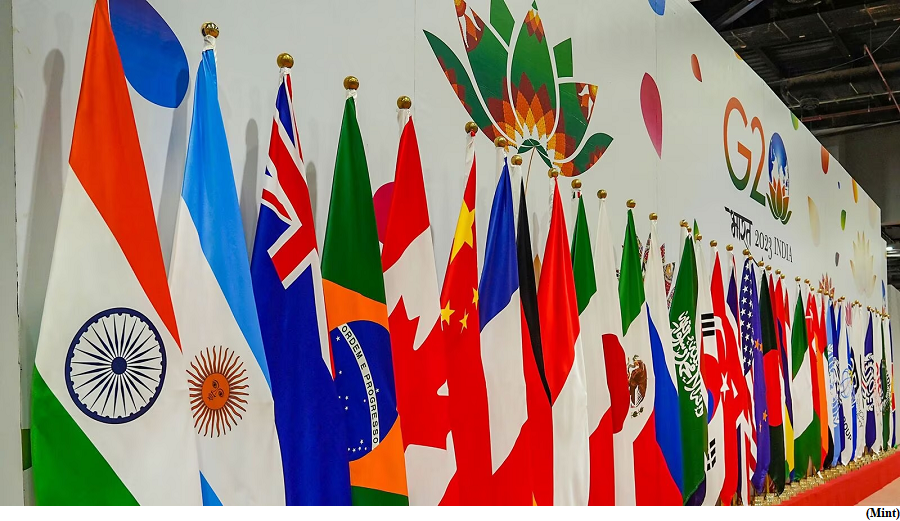Economic issues that G20 leaders agreed on (GS Paper 3, Economy)

Why in news?
- Recently, the G20 countries arrived at a consensus on the language of the New Delhi Declaration, and also adopted it.
- The G20 New Delhi Leaders’ Declaration laid out measures by which the countries involved would help the private sector accelerate growth, help MSMEs in developing countries to integrate better in global trade, and support skill development and financial inclusion across countries.
- The G20 countries noted that global economic growth was below its long-run average, and that it remained uneven.
Key Highlights:
- The declaration also took note of the swift actions taken by some developed economies in light of the banking turmoil in the recent past, and welcomed the steps taken by the Financial Stability Board (FSB), the Standard Setting Bodies (SSBs), and certain jurisdictions to examine what can be learnt from these episodes.
- Significantly for India, which has used its G20 presidency to push for the wider adoption of Digital Public Infrastructure (DPI) to enhance financial inclusion and service delivery, the declaration also made mention of New Delhi’s plans to make available DPI technology for countries that want to adopt such platforms.
Debt issue:
- Further, the G20 countries resolved to ensure that the multilateral development banks (MDBs), including the International Monetary Fund (IMF) and the World Bank, were adequately capitalised and ready to help the countries in need. They steps already taken towards this would ensure an additional $200 billion of loans would be available over the next decade.
- It called for the faster resolution of debt distress among the smaller economies that were suffering from high-levels of indebtedness following the COVID-19 pandemic, another item on the G20’s agenda that India was prioritising.
Cryptocurrencies:
- On the regulation of cryptocurrencies, they welcomed the synthesis paper by the IMF and the FSB that outlined the risks associated with cryptocurrencies and also laid out a roadmap for the adoption of crypto-related regulations by the member countries.
- They added that the recommendations of the paper would be discussed in the meeting of the G20 Finance Ministers and Central Bank Governors (FMCBG) in October. One of the key recommendations in the paper was that governments should not give cryptocurrencies the status of official currencies or legal tender
Enhancing digital public infrastructure:
- The G20 leaders recognised that digital public infrastructure, “respectful of human rights, personal data, privacy and intellectual property rights” can strengthen service delivery and innovation.
- This emphasis on personal data and privacy is of particular importance because, while a lot of developing countries have some keenness to work with India’s DPI portals like the Unified Payments Interface (UPI), Aadhaar, and CoWin, advanced economies have been wary, citing privacy and security concerns.
- The leaders welcomed the G20 Framework for Systems of Digital Public Infrastructure, a voluntary and suggested framework for the development, deployment and governance of DPI.
- It also took note of India’s proposal of a ‘One Future Alliance (OFA)’, which it said was a voluntary initiative aimed to build capacity, and provide technical assistance and adequate funding support for implementing DPI in low- and middle-income countries.
Strengthening multilateral development banks:
- The 21st century also requires an international development finance system that is fit for purpose, including for the scale of need and depth of the shocks facing developing countries, in particular the poorest and most vulnerable.
- The leaders endorsed the roadmap for the implementation of the recommendations of the G20 Independent Review of MDBs Capital Adequacy Frameworks (CAFs) and called for its implementation, keeping in mind the MDBs’ own governance frameworks.
- The initial CAF measures, including those under implementation and consideration, could potentially yield additional lending headroom of approximately $200 billion over the next decade, as estimated in the G20 CAF Roadmap.
BIS commits to the mission of quality conscious India through Gram Panchayats
(GS Paper 2, Governance)
Why in news?
- The Bureau of Indian Standards (BIS) has embarked on a mission to create awareness and promote compliance with Indian standards at the grassroots level.
- The BIS has undertaken a comprehensive initiative to sensitize Gram Panchayat Presidents and Secretaries across the country.

Objective:
- The primary objective of this initiative is to instill an understanding of the significance of adhering to Indian Standards among Gram Panchayats and ensuring compliance to these standards while implementing government programs and schemes at the village level.
- It aims to promote the culture of standardization and benefits of using products conforming to Indian Standards among Gram Panchayats, who play a crucial role in the execution of various government initiatives at the grassroots level.
Key Highlights of the Initiative are
- 2.4 Lakh Gram Panchayats reached out: BIS has communicated to all Gram Panchayats across the country. The Gram Panchayats are provided with booklet of important and useful Indian Standards relevant to different sectors, underlining the importance of adhering to these standards while executing various state/central government programs and schemes by the panchayats.
- Sensitization Workshops: BIS has also initiated training of Gram Panchayat Presidents and Secretaries in collaboration with state and district authorities across the country. These training programs for Presidents and Secretaries of Gram Panchayats are planned to be held at block and district levels through the nation-wide network of 38 BIS Branch Offices.
The benefits of the Initiative are:
- Enhanced Quality and Safety: By fostering compliance to Indian standards, the initiative aims to enhance the overall quality and safety of government programs and schemes implemented at the village level.
- Consumer Protection: Compliance with standards ensures that products and services meet specified quality and safety criteria, protecting consumers from substandard or unsafe offerings.
- Environmental Conservation: Adherence to standards can contribute to environmental protection by regulating processes that may have adverse ecological impacts.
- Capacity Building: The Sensitization Workshops are designed to empower Gram Panchayat officials with the knowledge and tools necessary to implement standards effectively.
- National Progress: The initiative aligns with the vision of a prosperous and progressive India by fostering a culture of quality and safety in all sectors.
- Awareness on BIS Care App: For empowering the consumers, BIS has also developed BIS Care App available for both Android and iOS Platforms. Consumers can use the app to access the information on Indian Standards, products covered under compulsory certification, list of BIS certified manufacturers, verifying authenticity of certified goods and materials, and mechanism to lodge the complaints in case of dissatisfaction, if any.
Gresham’s law, what happens when governments fix currency exchange rates
(GS Paper 3, Economy)
Why in news?
- Gresham’s law was in news during the economic crisis in Sri Lanka last year.
- The Central Bank of Sri Lanka has fixed the exchange rate between the Sri Lankan rupee and the U.S. dollar.

Application of Gresham’s law:
- Gresham’s law refers to the dictum that “bad money drives out good.” Gresham’s law comes into play when the exchange rate between two currencies is fixed by the government at a certain ratio that is different from the market exchange rate.
- Such price fixing causes the undervalued currency to go out of circulation. The overvalued currency, on the other hand, remains in circulation but it does not find enough buyers.
- The market exchange rate is essentially an equilibrium price at which the supply of a currency is equal to the demand for the currency.
- Also, the supply of a currency in the market rises as its price rises and falls as its price falls; while, on the other hand, the demand for a currency falls as its price rises and rises as its price falls.
- So, when the price of a currency is fixed by the government at a level below the market exchange rate, the currency’s supply drops while demand for the currency rises. Thus a price cap can lead to a currency shortage with demand for the currency outpacing supply.
Origins of the term:
- Gresham’s law is named after English financier Thomas Gresham who advised the English monarchy on financial matters. It applies not just to paper currencies but also to commodity currencies and other goods.
- In fact, whenever the price of any commodity is fixed arbitrarily such that it becomes undervalued when compared to the market exchange rate, this causes the commodity to disappear from the formal market.
- The only way to get hold of an undervalued commodity in such cases would be through the black market. Sometimes, countries can even witness the outflow of certain goods through their borders when they are forcibly undervalued by governments.
- Gresham’s law can be seen at play whenever a government fixes the exchange rate (or price) of a commodity money (such as gold and silver coins) far below than the market price of the commodity backing them.
- In such cases, people who hold the commodity money would stop offering the money at the price fixed by the government. They may even melt such commodity money to derive pure gold and silver that they can sell at the market price, which is higher than the rate fixed by the government.
Case of Sri Lanka:
- The Central Bank of Sri Lanka, at a certain point, mandated that the price of the U.S. dollar in terms of the Sri Lankan rupee should not rise beyond 200 rupees per dollar even though rates in the black market suggested that the U.S. dollar should sell for far more than 200 rupees.
- In effect, people were banned from paying more than 200 Sri Lankan rupees for a dollar, thus causing the rupee to be overvalued and the U.S. dollar to be undervalued when compared to the market exchange rate.
- This caused the supply of dollars in the market to fall and the U.S. dollar to be gradually driven out of the formal foreign exchange market. People who wanted U.S. dollars to purchase foreign goods then had to purchase dollars from the black market by paying far more than 200 Sri Lankan rupees for each U.S. dollar.
Thiers’ law:
- In the absence of any government decree fixing the exchange rate between currencies, it is good money that eventually drives bad money out of the market and not the other way round.
- When the exchange rate between currencies is not fixed and people have the choice to freely choose between currencies, people gradually stop using currencies that they consider to be of poor quality and adopt currencies that are found to be of better quality.
- This phenomenon wherein “good money drives out bad” is called Thiers’ law (named after French politician Adolphe Thiers) and it is seen as a complement to Gresham’s law.
- The rise of private cryptocurrencies in recent years has been cited by many analysts as an example of good money issued by private money producers driving out bad money issued by governments.




